When I moved out of my family home and into a city apartment, the one thing I couldn’t bring with me was my garden. Urban living has its perks, but finding a space to grow fresh herbs and veggies? Not so easy — especially if you’re short on space or always on the move.
That’s when I discovered portable greenhouses — lightweight, modular, and surprisingly sturdy. They let me recreate a micro-garden wherever I landed, making sustainable gardening not only possible but portable. Whether you’re working with a tiny balcony or a shared backyard, these compact structures help reduce food waste, lower your grocery footprint, and keep your green thumb thriving year-round.
In this guide, I’ll walk you through everything I’ve learned — from choosing the right size to understanding the best portable greenhouse brands that champion eco-friendly living. We’ll focus less on individual models and more on which greenhouse brands are making sustainability part of their mission — through durable designs, mindful manufacturing, and products built to last.
Let’s dig in and find the best portable greenhouse for your lifestyle — and the planet.
5 Best Portable Greenhouse Brands for Small Spaces
1. EAGLE PEAK: Building Greener Outdoor Spaces with Durability in Mind
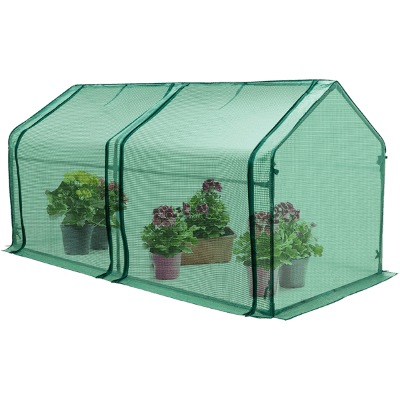
EAGLE PEAK might be best known for pop-up canopies and outdoor structures, but their portable greenhouses bring the same innovation to eco-conscious gardening. The brand prioritizes functionality and longevity — offering powder-coated steel frames and reinforced coverings that stand up to the elements, meaning less breakage, fewer replacements, and reduced waste.
While EAGLE PEAK doesn’t lead with sustainability messaging, their design philosophy speaks volumes. By focusing on reusable, weather-resistant structures, the brand helps reduce the throwaway culture that often plagues lower-end greenhouse kits. Their greenhouses also support self-sufficient lifestyles, making homegrown produce more accessible — a nod to reducing food miles and packaging waste.
In terms of production, EAGLE PEAK emphasizes sturdy materials and simplified setup, which minimizes the need for extra tools, fasteners, or wasteful packaging. Though they haven’t joined formal recycling or take-back programs yet, their product durability adds to a longer life cycle, which is a win for sustainable consumerism.
For gardeners looking for low-fuss, long-term solutions with eco-friendly benefits baked in, EAGLE PEAK’s greenhouses are a practical and quietly sustainable pick.
2. Quictent: Where Durable Design Meets Everyday Sustainability
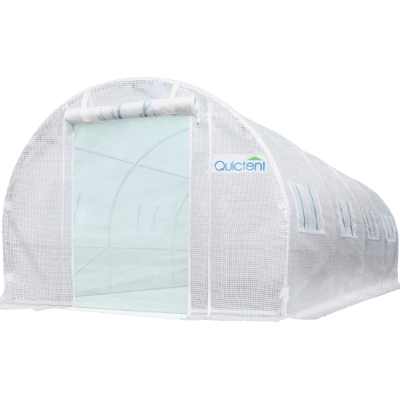
Quictent has carved out a niche in outdoor gear by offering high-value, highly functional structures — and their portable greenhouses are no exception. With reinforced steel frames and PE covers that resist tearing and UV damage, Quictent is all about extending product life while making home gardening more accessible.
Though the brand doesn’t front-load sustainability messaging, its product philosophy leans toward planet-friendly principles. By focusing on reusable structures instead of seasonal throwaways, Quictent encourages consumers to invest in longer-lasting solutions. That means fewer replacements, less plastic waste, and a greener gardening cycle over time.
From a production standpoint, Quictent emphasizes robust materials, compact packaging, and clear assembly instructions, helping reduce the footprint tied to returns and excess materials. And while the company hasn’t adopted take-back or closed-loop initiatives yet, their build-to-last mindset supports more conscious consumption habits.
For eco-minded growers seeking a greenhouse that balances affordability with durability, Quictent offers a smart middle ground — supporting greener habits without breaking the bank.
3. Home-Complete: Making Everyday Gardening More Sustainable
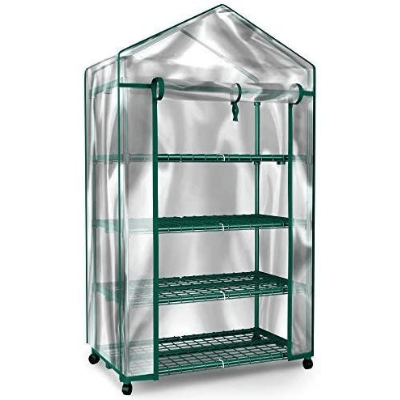
Home-Complete brings simplicity and utility to the world of portable greenhouses — ideal for beginner gardeners and apartment dwellers chasing that fresh basil dream. While the brand’s product line feels no-frills, its emphasis on accessibility and affordability promotes a key pillar of sustainability: helping more people grow their own food.
Their greenhouses are typically made with lightweight steel frames and PVC covers, designed to be compact, easy to assemble, and ideal for small spaces. While not explicitly marketed as eco-friendly, the product’s purpose — supporting local, at-home growing — encourages habits that reduce carbon footprints, grocery trips, and plastic-wrapped produce.
Home-Complete also gets points for promoting a more circular lifestyle. Their multi-tiered setups let you grow more in less space, and the frames can be reused season after season if cared for properly. Though the brand doesn’t yet offer recycling programs or use recycled materials, the design enables longer-term usage and cuts down on food waste from store-bought produce.
If you’re just starting your gardening journey or want a sustainable setup for tight spaces, Home-Complete offers a straightforward, grow-it-yourself solution that fits neatly into greener living goals.
4. Ohuhu: Cultivating Green Thumbs and Greener Habits
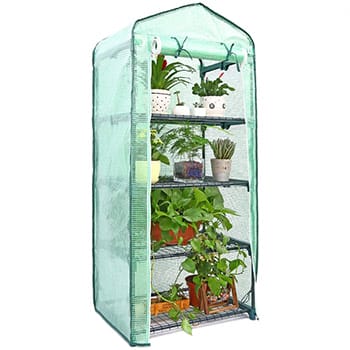
Ohuhu has built its reputation on functional, budget-friendly solutions across art supplies and home goods — and their portable greenhouses carry the same spirit. These structures are thoughtfully designed to help everyday gardeners protect their plants, extend growing seasons, and take control of their food supply — a quiet but powerful act of sustainability.
Ohuhu greenhouses feature rust-resistant metal frames and reinforced PE covers, offering protection from frost, pests, and unpredictable weather. This durability means fewer replacements and longer life cycles, which helps reduce waste in the long run. And while the brand doesn’t emphasize sustainability as a marketing point, the product itself supports greener lifestyles by enabling local food production and minimizing reliance on industrial agriculture.
From a manufacturing angle, Ohuhu leans into efficiency — with easy-to-assemble kits, minimal plastic packaging, and reusable materials. Though formal eco-certifications or recycling programs aren’t in place yet, the low-waste setup and multifunctional use make these greenhouses an excellent entry point for climate-conscious consumers.
Whether you’re an urban grower or a backyard gardener, Ohuhu makes sustainability feel approachable — proving that going green can start right at your doorstep.
5. Nova Microdermabrasion: Small Greenhouses with Big Eco-Friendly Intentions
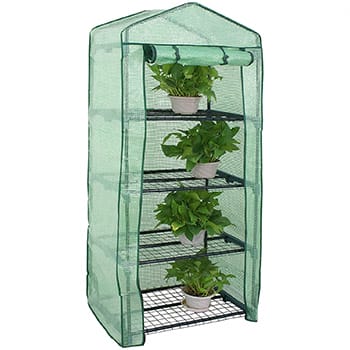
Better known for home and beauty products, Nova Microdermabrasion might seem like an unexpected player in the greenhouse space — but their portable greenhouses punch above their weight when it comes to eco-aligned living. With a surprising focus on environmental responsibility, the brand openly commits to using sustainable materials and reducing its ecological footprint where possible.
Their greenhouses are built for durability and year-round usability. UV-resistant covers, rust-resistant frames, and modular shelving systems give gardeners tools to grow more in compact spaces — reducing food packaging, food miles, and waste. The brand also emphasizes protective growing environments, which help reduce pesticide use and increase gardening success.
What sets Nova apart is their public stance on sustainability. They aim to weave eco-conscious practices into both manufacturing and shipping, opting for efficient packaging and minimal excess materials. While they don’t claim zero-waste operations, their push toward greener design is notable in a product category often dominated by single-season kits.
For those seeking a sustainable option that doesn’t skimp on design or ethics, Nova Microdermabrasion’s greenhouses offer a welcome fusion of practicality and purpose.
Types of Portable Greenhouses: Aren’t They All Same?
When I first heard about portable greenhouses, I thought, “Aren’t they all pretty much the same?”
But nope, I was wrong.
There’s a whole world of them out there, each with its own perks. Let me walk you through what I found – it’s like a mini adventure in the world of gardening!
1. The Petite Powerhouse: Portable Mini Greenhouse

Think small but mighty. These mini greenhouses are super light and usually come with 3 or 4 shelves. Some even have adjustable shelves – a big plus for your taller green babies. They come in three styles:
- Vertical — Perfect for your balcony or small yard.
- Horizontal — Great for covering ground plants or low beds.
- Tabletop — Ideal for indoor or outdoor tables.
Mini portable greenhouses are usually 2 to 6 feet tall, and they have an opening that you can roll up and down and close with a zipper.
They are easy to set up. In most cases, you won’t need any tools. They are made of clear polyethylene and iron tubing, so you don’t have to worry about rust and corrosion if you place it outside.
Pro Tip: Mini greenhouses are usually lightweight, so you may need to weigh them down on windy days if you place them outdoors.
2. Step Right In: Portable Walk-In Greenhouse
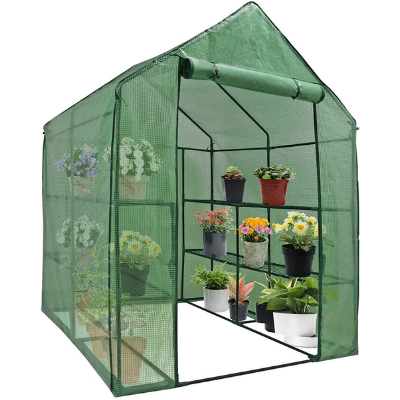
This one’s like a cozy room for your plants. They’re bigger than mini greenhouses but still compact enough. Great for both indoors and outdoors, they’re perfect for storing not just plants, but also your gardening tools.
I often keep my natural pesticides in mine. They typically have no floor, so you’re standing on whatever surface they’re placed on. They’re easy to assemble (snap and go!) and light enough to move when empty.
Pro Tip: Secure it well if it’s placed on concrete, especially on windy days.
3. The Big Deal: Large Portable Greenhouse

Fancy a tunnel?
The portable tunnel greenhouse is your go-to. No wheels, no floor, but walkable and perfect for larger gardens.
They come in lengths up to 20 feet and are great for frost protection.
Choose one with two doors for better air circulation. They’re heavier due to the powder-coated steel frame but still manageable, especially with a buddy for the cover setup.
4. Sturdy and Strong: Compact Greenhouse
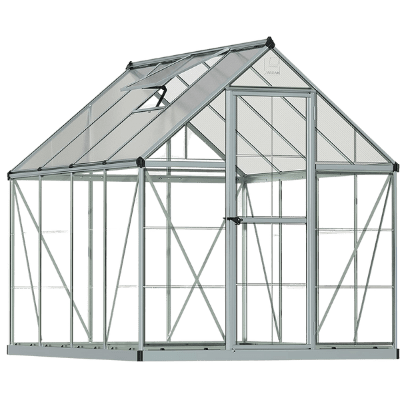
This one’s the tough cookie – heavier (45 to 75 pounds) and sturdier, mimicking traditional greenhouses. With a door latch, vents, gutters, and lock, it’s a serious player.
It uses UV-resistant polycarbonate sheets and an aluminum frame.
It’s wind-resistant up to 12 mph but might need anchoring in stormy areas. The cool part? You get better control over the internal conditions compared to others.
5. Roll With It: Portable Greenhouse on Wheels

Last but not least, the wheeled wonder. It’s a bit heavier, but those wheels make it a breeze to move around.
Need more space? Just roll it to a new spot.
You can DIY this one too. Get a portable greenhouse, fit a floor, slap on some wheels, and voila!
These are great for indoor use, offering unmatched flexibility and freedom.
So there you have it, the lowdown on portable greenhouses. Each has its charm, and honestly, it’s hard to pick a favorite. Which one catches your eye?
What to Look for When Buying a Portable Greenhouse
Picking the right portable greenhouse can be tricky. Let’s break down what you need to consider:
1. Frame Material: Strength and Durability
Wooden Frames:
Also known as cold frames, they’re great for year-round use in milder climates. But, they can rot in damp conditions. You’ll need to sand and re-stain them occasionally.
Metal Frames:
These are usually aluminum or powder-coated steel. They’re low-maintenance, easy to assemble (often just snapping together), and rust-resistant.
2. Siding Material: The Right Cover
Plastic Siding:
Common in mini greenhouses, plastic is lightweight and easy to move. But watch out – it can get too hot inside. Make sure there’s good ventilation, like roll-up windows or doors. And in windy areas, you’ll need strong stakes to keep it grounded.
Glass Siding:
If you’re going for a more premium look, glass is your friend. It’s excellent for harsh weather and lets in plenty of sunlight for seedlings. But remember, glass can break easily, especially if you move your greenhouse a lot.
An alternative?
Poly-carbonate panels – they’re sturdier but let in less light.
Remember, each material has its pros and cons. Think about your climate, how often you’ll move the greenhouse, and what you’ll be growing. These factors will help you decide the best material for your needs.
3. Weight
When you’re in the market for a portable greenhouse, one of the first things to think about is its weight. Here’s how it breaks down:
Plastic Siding: Light and easy to move. If you’re planning to shift your greenhouse often, this is a great choice.
Metal Frames vs. Wooden Frames: Metal, especially the lightweight types, is usually lighter than wood. This means easier movement and less hassle.
Glass Panels: They add a touch of class, but they also add weight. If you’re eyeing a greenhouse with glass panels, be prepared for the extra heft.
Size Matters: A typical compact greenhouse ranges from 45 to 75 pounds. The smaller mini greenhouses are lighter, but if you go for a greenhouse on wheels, expect it to be on the heavier side.
In my experience, choosing the right weight depends on how often you plan to move your greenhouse. If it’s going to stay put most of the time, a heavier option might be fine. But if you’re like me, always rearranging your garden space, lighter is better. Remember, the right balance of durability and portability is key!
4. Size Matters: Fit for Your Space
Whether it’s a cozy balcony, a city patio, or a spacious backyard, there’s a greenhouse for every size. Most are under 6 feet tall. Compact ones are about 10 square feet, and tabletop versions are smaller.
Before buying, measure your outdoor space, and don’t forget to think about indoor space if you plan to move it inside during colder months.
5. Shelves: Storage and Space Efficiency
Shelves usually match the frame’s material – wood, metal, or plastic. Some have adjustable shelves for different plant sizes, while others are fixed.
Remember, upper shelves might block sunlight for seedlings below.
6. The Kit: What’s Included?
Kits range from simple plant-and-hardware boxes to more elaborate setups. I recommend getting a full kit, not just the frame. Check for included covers.
Most kits are like setting up a tent, with flexible rods and straightforward instructions.
Typically, you’ll find steel or aluminum frames, plastic sheets, and a PVC waterproof canopy roof.
If you’re good with tools, you could even build your own greenhouse.
What to Look for in a Kit:
- Movable Shelves: They offer flexibility for plant sizes.
- Zippered Doors: For ventilation and easy access.
- Clear Cover: To let in plenty of sunlight.
- Sturdy Stakes: For secure installation.
7. Watering: Keep it Hydrated
Place your greenhouse near a water source. Remember, plants inside won’t get rainwater, so they rely entirely on you. Having water nearby makes your gardening life much easier.
8. Power Source: Stay Powered Up
If you need a heater in colder months, keep your greenhouse close to an electrical outlet. An extension cord might work, but always think about safety. If in doubt, get an electrician’s advice or have them install a power outlet in your greenhouse.
9. Lighting: Let There Be Light
Even in a clear greenhouse, remember that winter days are shorter and cloudier. Your plants still need their light.
You also need to see your plants clearly, so consider additional lighting.
Some fancy greenhouses come with lights. If yours doesn’t, think about getting grow lights or installing LED lights.
10. Ventilation: Keep the Air Flowing
Good air circulation is key to managing heat and moisture.
Many small greenhouses have zippered doors – great for letting air in, especially in summer. If you’re choosing a tunnel greenhouse, one with two doors is ideal for airflow.
Make sure there’s at least one opening for ventilation, no matter the size of your greenhouse.
Why Should You Get a Portable Greenhouse?
Here are my top reasons why everyone should own a portable greenhouse.
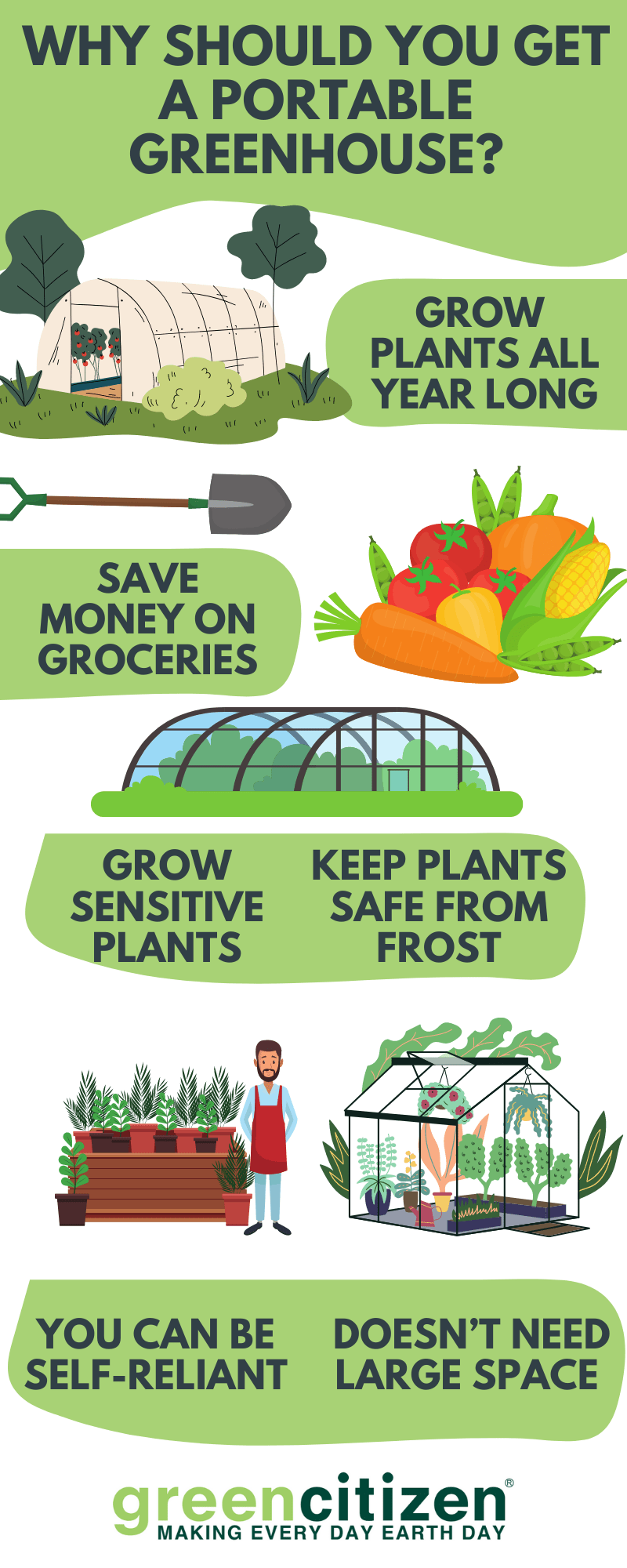
Grow Plants All Year Long
With a portable greenhouse, you won’t have to limit yourself to eating only the produce that’s in season. You can grow your favorite veggies throughout the year.
A portable greenhouse is easy to move. If your plants like more sun, simply move it to a sunnier place in your home or property to ensure it has the optimal conditions to grow.
A portable greenhouse is the answer if you want to extend the growing season or cultivate a plant all year long.
Save Money on Groceries
This one goes hand in hand with growing plants all year long.
You can grow peas, kale, lettuce, and many other vegetables yourself, which will significantly reduce how much money you shell out for groceries.
You’ll also be saving money on gas, as you don’t have to drive to the grocery store. Just walk into your portable greenhouse and get the veggies you need for your salad.
Not to mention, this is also better for the environment.
Grow Sensitive Plants
I LOVE orchids. However, it took me years before I learned how to grow and take care of them successfully, and one of the things that helped a lot was a greenhouse.
Orchids are extremely temperature-sensitive. They aren’t used to colder seasons, and they love humid conditions.
I was able to recreate a perfect environment for orchids in my portable mini greenhouse, so they flourished even during the freezing winter months. This makes winter gardening so easy.
Of course, you can also grow other sensitive plants — I also grow key lime and mandarin orange, both of which don’t do well in freezing temperatures. Or, you can move the greenhouse from outdoors to indoors if your plants love warmer temperatures.
Keep Plants Safe from Frost
I grew up watching my mom religiously checking the weather forecast once autumn starts and throwing old sheets, blankets, and cloths over plants.
I found an easier solution to keep the plants safe from frost — a small winter greenhouse.
Most greenhouses don’t have flooring, so placing them over plants or low-lying flower beds is easy.
Once the frost is over, I simply remove it, and my plants are safe.
Take It with You
I’m talking from personal experience, as someone who moved several times in the last couple of years. I was able to take my portable greenhouse with me.
If you have to relocate because of job requirements, family, or other reasons, a portable greenhouse can come with you, especially a mini one.
You’ll be saving up a ton of time, as you won’t have to set up a new garden every time you move. And you won’t have to leave it behind and abandon all the effort you’ve put into growing your garden.
You Can Be Self-Reliant
I’ve already mentioned how growing your own veggies will save you money. But, it also means you’ll be independent.
In case of a natural disaster or a global pandemic, which we all saw is a scenario that can easily happen, you won’t have to go out and mix with other people.
You can grow a lot of the food you need on your own and be safe knowing you won’t starve.
You Don’t Need a Large Space For It
Portable greenhouses come in different sizes, and there are many small greenhouse variations. This means, even if you don’t have a huge yard, you can still have a greenhouse.
Small portable greenhouses are usually vertical, and they have shelves on which you can put your plants and a zippered door that you can roll up or down.
You can place them on a patio, balcony, even on a table if you go for a tabletop greenhouse. This is also convenient if you live in a small space. You can move a portable greenhouse out of the way when needed.
Because they are so small, they are lightweight, and you can move them around your home or take them with you when you move homes.
Grow Green, Choose Wisely
Portable greenhouses do more than just protect your plants — they protect your values. Whether you’re nurturing herbs on a fire escape or building a backyard veggie haven, the brand you choose matters. The best portable greenhouse brands don’t just build frames and covers; they support sustainable lifestyles through ethical manufacturing, long-lasting materials, and thoughtful design.
As you explore your options, look beyond features and price tags. Pay attention to brand ethics, how products are made, and what kind of environmental footprint they leave behind. Choosing a greenhouse that aligns with your eco-goals means you’re not just growing plants — you’re growing a better future.
Ready to find the greenhouse that supports your green lifestyle? Start with brands that care as much about the planet as you do.


